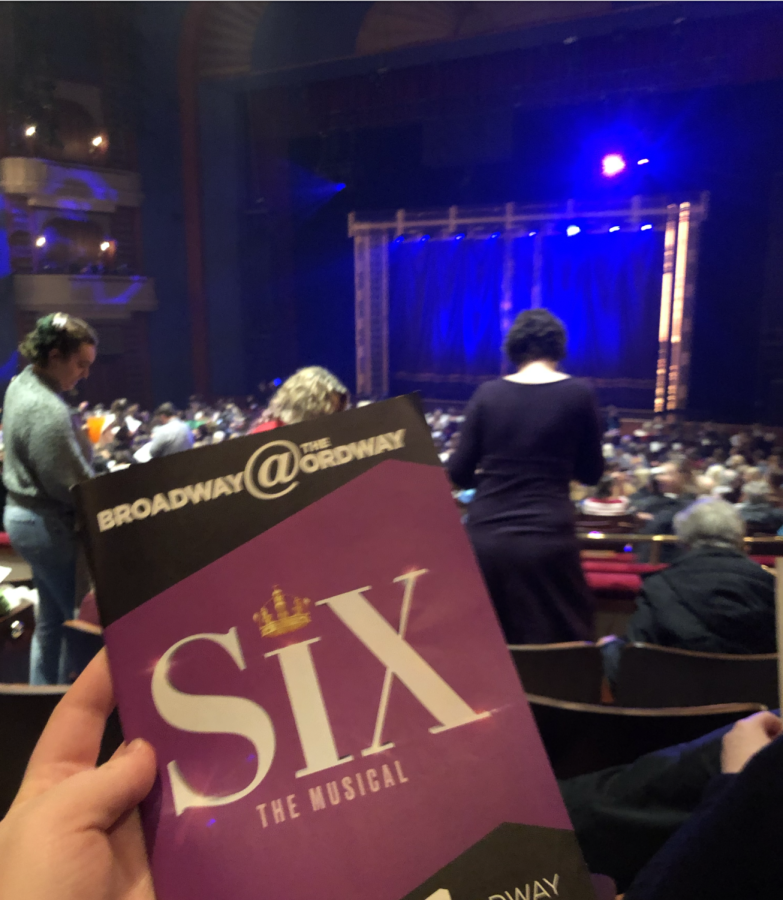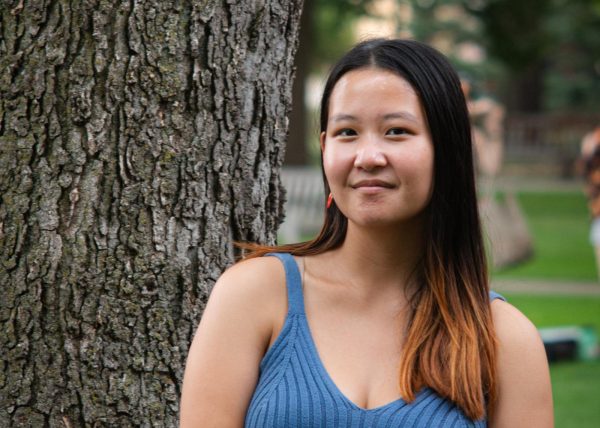Hearing “her-story”: an analysis of “Six! The Musical”
November 10, 2022
If you had the chance to visit the Ordway Theater for the Performing Arts in St. Paul between Oct. 25 and Nov. 6, you might have heard a lot of people walking around with ridiculous fake British accents, or perhaps running about like a chicken (or person) with their head cut off.
The show at the Ordway is a part of the Broadway on Tour series, where a cast travels across the U.S. to perform at different major theaters for a short period of time. There are currently two casts on tour performing “Six! The Musical”: the Aragorn tour and the Boleyn tour, the latter being the one which performed at the Ordway.
“Six! The Musical,” a show written by Lucy Moss and Toby Marlow, is about the six wives of King Henry VIII of England, who gained infamy from his decisions as monarch and the horrors he committed in his attempts to gain a legitimate male heir.
The premise of the musical is a competition between the queens where they debate who had the worst life and suffered the most hardships at the hand of their mutual husband. They each speak (and sing) about their own experiences, and the musical incorporates semi-historical context.
The musical has a small, six person, all female cast, depicting the six queens. The Boleyn Tour for “Six!” features Gerianne Perez as Catherine of Aragon, Zan Berube as Anne Boleyn, Amina Faye as Jane Seymour, Terica Marie as Anna of Cleves, Aline Mayagoitia as Katherine Howard and Sydney Parra as Catherine Parr.
Across most of the “Six!” casts, including the West End, Australian and U.S. original Broadway casts, “Six!” has deviated from historical accuracy in casting. Instead, all casts of the show have chosen to favor a more diverse cast of actresses rather than limiting the casting to those who fit the physical and racial profile of the original queens.
Originally a British musical, the American casts of “Six!” have had to make some changes to the lyrics of some of the songs in order to retain the rhyming words at the end of some of the lines, due to differences in pronunciation between the British and American English accents. Interestingly, the American casts have chosen to have the actresses sing in their original accent, rather than adopting a British accent as many actors are more than capable of doing.
The show combines historical and modern elements, with frequent use of modern slang and references to modern technology. Anne Boleyn’s song, “Don’t Lose Ur Head,” includes lyrics such as “he wanted me, obviously, kept messaging me like every day” and “your comment went viral! I didn’t really mean it but rumors spiral,” both of which reference texting and social media. In the second group number “Haus of Holbein,” the queens move through a mock dating app skit, where they “swipe” left and right on potential suitors that King Henry the VIII considered for marriage before finally settling on Anna of Cleves.
Still, the show makes an effort to retain some of the historical elements of the time. In Katherine Howard’s song “All You Wanna Do,” she references a quill and ink, parchment and the corset style of dress that would have been worn.
The combination of past and present is represented perfectly in the costumes, which are pop-group modernized dresses containing vibrant colors, sequins and gems made in a short style. However, some also have the high, stiff collars of the time, the puffed out sleeves and corset-esque bodices.
At the Ordway, the show incorporated a significant amount of neon and LED lighting to set the scene and bring the concept of the queens performing as a modern pop group to life. The background is set up so that symbols representing subjects discussed throughout the musical can be lit up when the time is right, such as crosses for discussions of the Catholic Church.
The actresses engage in short bouts of banter outside of the songs that are the main focus of the show, which has an 80 minute run-time, without an intermission. Within the show, there are six solo songs, one for each queen, three group numbers, one at the start and end of the show and one that splits it down the center between the first and second three songs.
In correspondence with the famous mnemonic device “divorced, beheaded, died, divorced, beheaded, survived,” the themes of the first three and second three queens songs correspond. This has a basis in their incredibly intertwined lives, as well as the phrase itself.
Both Jane Seymour and Catherine Parr sing songs addressed to the loves of their lives, in Jane’s case to Henry himself, and in Catherine’s case to Thomas Seymour, who was Jane’s brother and who she later married after Henry’s death.
Anne Boleyn and Katherine Howard, the beheaded queens, both lament about how their social decisions impacted their misfortune, and their content has strong themes regarding the lack of choices for women in society at the time. Boleyn sings a line about the role her father played in getting her and Henry married, stating “and soon my daddy said ‘you should try and get ahead’”. Historically, her father’s role was even larger, and Anne’s sister, Mary, actually had two illegitimate children with Henry prior to Anne’s marriage to him.
Ironically, Anne and Katherine are related as well — they’re cousins. Katherine’s song has an extremely dark tone as well, with her singing a total of four choruses regarding the influence that the men in her life exerted over her. Socially, she was known for her promiscuity, which later led to her execution. Her song, however, reveals the emotional turmoil that she went through as a very young girl, as men in her life manipulated their power dynamic to make her feel valued as they used her for her body.
Catherine of Aragon, the beloved infanta (the youngest princess of the royal family) of Spain and daughter of Ferdinand and Isabella, was Henry’s longest lasting wife. Her divorced counterpart, Anna of Cleves (also known as Anne), was married to Henry for the shortest amount of time. The two are also the only international queens, with Catherine being from Spain and Anna from Germany.
Similarly to one another, the two queens were sent away from court while still married to Henry, though Catherine claimed to be married to Henry long after he had publicly married Anne Boleyn and denounced the Vatican and the Pope. Anna, on the other hand, was awarded a palace in Richmond and remained close to Henry after their divorce, so much so that she became known as “the king’s sister”.
The overall takeaway from the show is one of female empowerment, with the queens rewriting “his-story” into “her-story” in an effort to distance who they were as people from the baseline perceptions of the public, which are almost solely in relation to their husband.
In the opening song, “Ex Wives,” Katherine Howard sings “I’m done, cause all this time, I’ve been just one word in a stupid rhyme,” referring to the “Divorced, Beheaded, Died … etc” term that people use to remember the queens. The show also ends with a song that is centered around the idea of the lives that the queens could have lived had they not married Henry, and includes lyrics such as “We’re one of a kind, no category, too many years lost in his story,” and “Now I don’t need your love, all I need is six.”
To learn more about “Six! The Musical,” check out sixthemusical.com.














